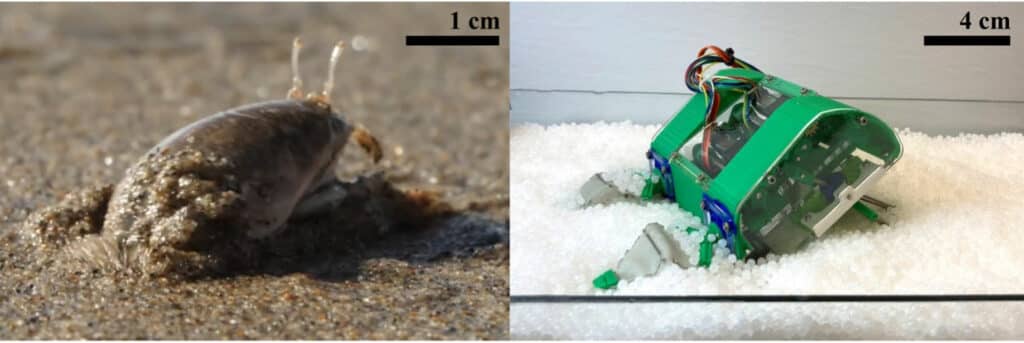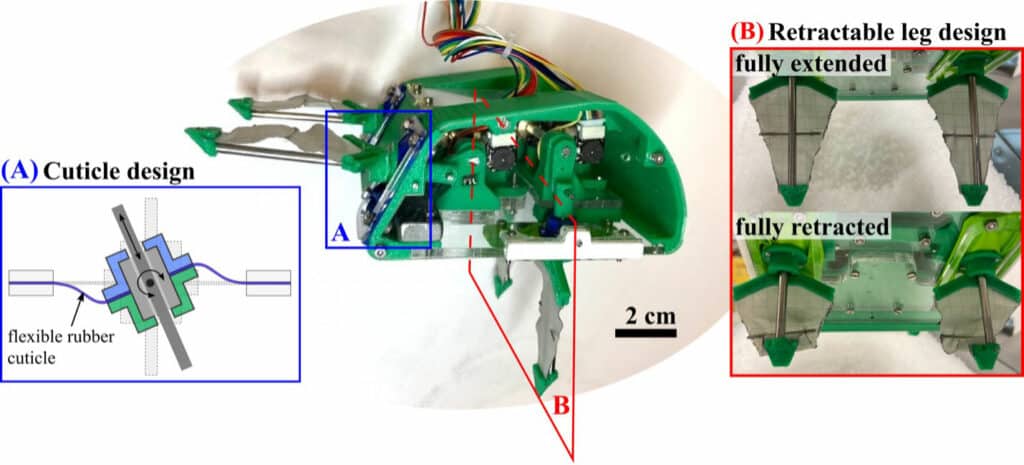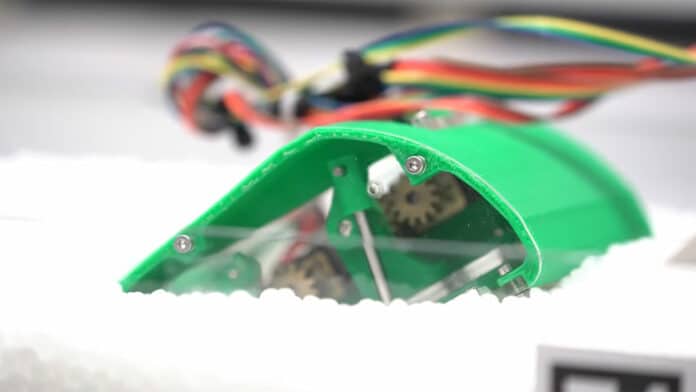While robots are now capable of robustly performing a wide variety of tasks in a wide variety of environments such as land, space, and sea, they have not made significant inroads underground. Very few robots, for example, can self-burrow under their own weight.
Now, UC Berkeley researchers have debuted a unique robot inspired by Emerita analoga, the Pacific mole crab, that may someday help evaluate the soil of agricultural sites, collect marine data, and study soil and rock conditions at construction sites. Called EMBUR (EMerita BUrrowing Robot), this digging robot uses a novel leg design to achieve downward motion that emulates the way Pacific mole crabs bury themselves in beach sand.
To create a vertical-legged burrower, the researchers designed the legs of the robot to have an anisotropic force response, which means that they experience a much greater force in one direction than another. The soft fabric legs of this robot expand for large forces during the power stroke but fold and retract during the return stroke.

“There have been some recent advances in creating anisotropic legs for granular media, but this is the first time they have been implemented successfully on a free-burrowing robot,” said Laura Treers, the study’s lead author.
Researchers also devised a way to prevent sand grains from entering the robot’s mechanisms and jamming them. They again turned to the Pacific mole crab for inspiration. “We created a cuticle, which is analogous to the arthrodial membrane found on the mole crabs,” said Treers. “It’s a soft, flexible material that lines the openings of joints to prevent grains from getting inside but still allows free movement.”
To design the legs on EMBUR, researchers first observed and analyzed mole crabs in the lab. They quickly realized that the animal’s five leg pairs could be split into two groups, which sweep in opposite directions to one another. The team also noticed a pattern of insertion, sweeping, and retraction, with the latter appearing to reduce drag on the return stroke. They then attempted to reproduce both features in the robot’s leg design.

To help guide them in the robotic implementation, the researchers used physics models to estimate the forces on the legs. “We used a modeling technique known as Resistive Force Theory [RFT] to model the forces experienced by the legs throughout their sweeping trajectories,” said Treers. “RFT helped us understand the kinds of robot geometries and behaviors that would allow for the most successful burrowing.”
Through EMBUR, Berkeley researchers showed that vertical-legged burrowing is possible in dry media under the right conditions. They consider this a first step toward creating a system that can burrow under a wider range of conditions and types of substrates, like on a real beach.
Such robots could be used in a variety of industries and fields of study, including gauging the soil quality of potential agricultural sites, geotechnical engineering, marine data collection, and construction and excavation. Also, they could serve as small deployable anchors from marine vehicles or space rovers, to allow for tethered teamwork between robots.
“We plan to improve the design to allow for deeper digging and exploring better modeling methods, like DEM [Discrete Element Methods], to help predict the robot behavior,” said Treers. “Eventually, I’d love to have this robot be able to dig in real beach settings, like the animal, and switch between running, swimming, and digging.”
Journal reference:
- Laura K. Treers, Benjamin McInroe, Robert J. Full and Hannah S. Stuart. Mole crab-inspired vertical self-burrowing. Frontiers in Robotics & AI, 2022; DOI: 10.3389/frobt.2022.999392
